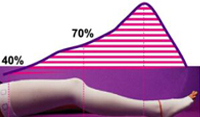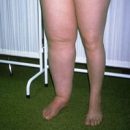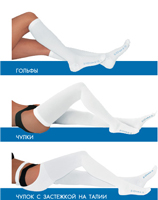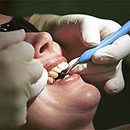Compression therapy is widely used in the treatment of thrombophlebitis. Compression bandages and compression knitwear products create optimal pressure in the venous system, which prevents the blood and development of the disease.
Content
Concept of compression therapy
The history of the compression treatment of diseases of the centers of the lower extremities goes its roots in the depths of centuries. The most ancient known evidence of this are images of dancing people with bandages on the legs found in the Sahara desert area. The age of these rock paintings is at least 4000 years. Bandages were also known in Ancient Egypt. Meanwhile, in the ancient times of the Jews, the Greeks and Romans used compression for the treatment of trophic ulcers of lower extremities. Hippocrates reports even about local compression with special sponges.
Currently, compression therapy in the complex treatment of chronic venous insufficiency of the lower limbs occupies a key place. It is shown in any extent of venous insufficiency, regardless of its cause. Practically the only contraindication to elastic compression are chronic binding diseases of the lower limb arteries.
Varieties of compression bands
All compression bandages are divided into three groups:
- Bandages with short stretchiness increase their length no more than 70%
- Medium extensibility bandages are lengthened in the range of 70-140%
- Long extension bandages Increased length by more than 140%
 The therapeutic effect of the compression bandage is largely determined by the properties of the material from which it is formed. For its technical characteristics, the following parameters have been entered:
The therapeutic effect of the compression bandage is largely determined by the properties of the material from which it is formed. For its technical characteristics, the following parameters have been entered:
- People's pressure is the force with which the bandage or compression stocking is put on the leg with relaxed muscles
- Working pressure is the force with which the bandage puts on the leg with muscular reduction
Obviously, to achieve the therapeutic effect of a compression bandage, bandages that provide high operating pressure at low pressure alone. These are bandages of short and medium extensibility. Long stretching bandages are used to fix multilayer compression bandages or for preventing bleeding and hematoma immediately after surgery on the subcutaneous veins of the lower extremities.
Features of the use of a compression bandage
Rules for the formation of a compression bandage from bandages:
- The bandage is imposed on the rear bending of the foot, which warns the formation of folds in the ankle area, as the folds can damage the skin when driving
- The bandage must reach the proximal joints of the fingers of the foot and capture the heel
- Bandage pressure should slightly weaken from the ankle in the proximal direction
- When attaching a bandage, the bandage roll is spinning outward, while it is in close proximity to the skin
- It is necessary to model a cylindrical limb profile by overlaying it on its flat parts (the rear of the feet, the varnishing pits) of foam or latex pads
- The imposition of a compression bandage must correspond to the form of a leg, t. E. With conic form, the bandage tours must go in the upstream and downward directions
With a properly superimposed compression band, the fingertips are slightly shine slightly, and at the beginning of the walk restore your usual color. Compression dressings change daily or superimposed for a long time (up to 2 months).
Therapeutic compression knitwear in the treatment of thrombophlebitis
With compression therapy uses special medical knitwear. The essence of the method of creating an external pressure to compensate for increased hydrostatic and tissue pressure during thrombophlebitis in order to reduce stagnant phenomena and preserve the normal diameter of the veins.
Modern compression knitwear provides accurate graded pressure distribution with a decrease in compression from foot to the thigh.
Therapeutic compression knitwear compared to traditional elastic bandage has very significant advantages:
- The physiological distribution of pressure does not depend on the patient's skills or a doctor, but is programmed with machine knitting
- Not required medical participation (with the exception of the choice of class compression)
- No need to simulate a cylindrical limb profile, since its anatomical features are taken into account in the manufacture of a compression product
- Complies with aesthetic requirements
- Creates favorable conditions for the water and temperature balance of the leather limb
- Possible selection of optimal pressure in accordance with the compression class of the product
Compression knitwear is more convenient in use, and the mechanism of action is the same as that of correctly imposed elastic bandages. Currently, products from elastic knitwear are divided into 4 classes (depending on the degree of compression):
- Grade 1 - 18.4-21.2 mm RT.Art.
- Grade 2 - 25.1-32.1 mm RT.Art.
- Grade 3 - 36.4-46.5 mm RT.Art.
- 4th grade - above 59 mm RT.Art.
Selection of the necessary compression knitware products are carried out under the guidance of the doctor, based on the specific pathology of the patient and its individual anatomical features.









